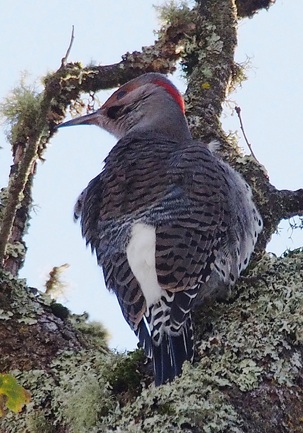A practical guide to bird watching in Sonoma County, California
(Unless otherwise indicated, all phone numbers are in the 707 area code)
A practical guide to bird watching in Sonoma County, California
(Unless otherwise indicated, all phone numbers are in the 707 area code)


Permanent resident in the wooded areas of the county, but appears much more common in the winter months as birds come down to lower elevations and begin to appear in closer proximity to human activity, and birds from more northern populations move south to find warmer weather. Very common in suburban areas and parks in the winter. Less common in the flat, marshy areas in the southern extremes of the county. Generally looks and behaves like a woodpecker, but eats mostly ants and other insects, so much more likely to be seen on the ground than other woodpeckers and relatives--sometimes looking like a Robin as it searches for food in grassy or other open areas. Favors wooded areas with open ground nearby for foraging. Typical, undulating, woodpecker flight with a white rump patch and underwing and undertail color especially prominent in flight. Nests in most parts of Sonoma County. Usually quite wary of people.
Always distinctive, but can be confusing because Northern Flicker takes two forms and intergrades are not uncommon near range overlap and occasionally in our area from Autumn through Spring. However, we normally see the Western form, known as Red-shafted Flicker. Yellow-shafted Flicker is the common variety in the East. The most obvious difference is in the coloring of the underwing and undertail linings visible in flight; our flickers flash salmon pink when they fly or raise a wing (photo below). Eastern birds show yellow under the wings.

Gilded Flicker (Colaptes chrysoides), currently given full species status, has in the past been considered a subspecies of Northern Flicker. It’s very similar but not usually present in our area (native to southwestern Arizona, Baja California, and extreme northwestern Mexico). Some of the older sources given below (such as The Birder’s Handbook) treat Gilded Flicker as a subspecies of Northern Flicker.
Calls are worth studying, as Flickers can sound like Red-shouldered Hawks (Buteo lineatus), Pileated Woodpeckers (Drycopus pileatus), and even Steller’s Jays (Cyanocitta stelleri), which sometimes imitate the vocalizations of other birds.
Trivia: The pink tail and wing feathers were highly prized by native Americans for ornamental purposes (Fix and Bezener).
English synonyms: Northern Flicker, Red-shafted Flicker, Yellow-shafted Flicker. May also be referred to in some areas (though not typically in Sonoma County) as: Yellowhammer, Boreal Flicker, or Common Flicker (among others).
Northern Flicker in other languages (may refer either to the Red- or Yellow-shafted forms)--German Goldspecht; Spanish: Carpintero Alirrojo, Carpintero Collarejo, Carpintero de Cañones Amarillos, Carpintero de Pechera, Carpintero Dorado, Carpintero Escapulario, Carpintero norteño, Checo norteño; French: Pic doré, Pic flamboyant, Pic rosé; Russian: Золотой дятел, Золотой шилоклювый дятел, шилоклювый дятел; Japanese: ハシボソキツツキ (hashibosokitsutsuki); Chinese: 北扑翅鴷, 普通扑动鴷
(Language information from Avibase, Birds of Europe (Mullarney et al, Princeton Field Guide Series), and Birds of Asia (Mark Brazil, Princeton Field Guide Series).
Further reading:
Bolander and Parmeter, Birds of Sonoma County California, rev. ed., 2000, p. 80
Brinkley, National Wildlife Federation Field Guide to Birds of North America, 2007, p. 284
Burridge, ed., Sonoma County Breeding Bird Atlas, 1995, p. 96
Dunn and Alderfer, eds., National Geographic Field Guide to the Birds of North America, 5th ed., 2006, p. 284
Dunn and Alderfer, eds., National Geographic Field Guide to the Birds of North America, 6th ed., 2011, p. 322
Dunne, Pete Dunne’s Essential Field Guide Companion, 2006, pp. 387-388
Ehrlich, Dobkin, and Wheye, The Birder's Handbook, paperback edition, 1988, p. 338
Fix and Bezener, Birds of Northern California, 2000, p. 237
Floyd, Smithsonian Field Guide to the Birds of North America, 2008, p. 280
Kaufman, Field Guide to Birds of North America, 2000, p. 218
Kaufman, Field Guide to Advanced Birding, 2011, pp. 11, 124, 343
Lukas, Bay Area Birds: From Sonoma County to Monterey Bay, 2012, pp. 173-174
Parmeter and Wight, Birds of Sonoma County California, Update (2000-2010), 2012, p. 47
Peterson, Birds of Eastern and Central North America, 5th ed., 2002, p. 218
Peterson, Field Guide to Birds of Western North America, 4th ed., 2010, p. 238
Peterson, Western Birds, 3rd ed., 1990, p. 226
Sibley, Field Guide to Birds of Western North America,1st ed., 2003, p. 264
Stokes, Stokes Field Guide to the Birds of North America, 1st ed., 2010, p. 450
Vuilleumier, American Museum of Natural History, Birds of North America: Western Region, 2011, p. 241
Voice: Cornell Lab of Ornithology: All About Birds--Northern Flicker
© Colin Talcroft, 2009-2017
Unless noted, all photos by the author. If you would like to use one of my images, please ask for permission for non-commercial use with proper credit or commercial use with proper compensation.
Northern Flicker
Colaptes auratus
Northern Flicker (male, red-shafted form), Stone Castle Lane, Santa Rosa, February 5, 2015
1990-2014 Sonoma County data. Graph provided by eBird (www.ebird.org), generated February 5, 2015
EBird reported occurrence in Sonoma County


Northern Flicker (male, red-shafted form), Stone Castle Lane, Santa Rosa, February 5, 2015
Preening, offering a good view of the salmon-pink underside of a wing.


(Red-shafted form)
Northern Flicker (male, yellow-shafted form; two shots of same individual), Strawberry School Park, December 18, 2016
Note red nape and black rather than red malar stripe

